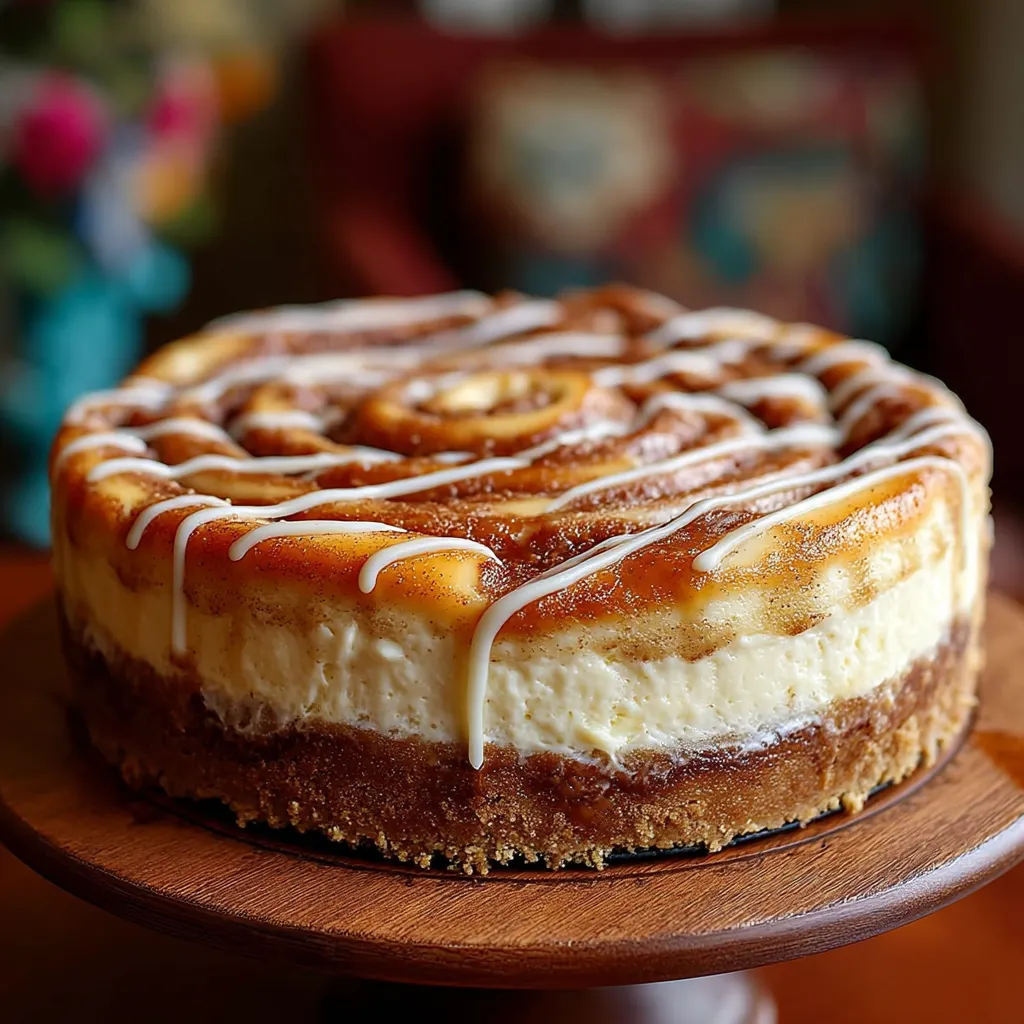 Save
Save
This Cinnamon Roll Honeybun Cheesecake brings together two beloved desserts into one magnificent creation. The rich, creamy cheesecake layer swirled with brown sugar cinnamon creates that nostalgic honeybun flavor, all resting on a perfectly spiced graham cracker crust and topped with a sweet vanilla glaze that ties everything together.
I created this recipe for my daughter's 16th birthday when she requested something "different but familiar." The moment everyone took their first bite, the table fell silent before erupting in praise. Now it's our most requested holiday dessert.
Ingredients
- Graham Cracker Crust
- Graham cracker crumbs these create the perfect cinnamon roll inspired base. Look for finely crushed crumbs or pulse whole crackers in a food processor
- Unsalted butter use quality butter for best flavor and melts more consistently
- Granulated sugar adds sweetness and helps bind the crust
- Ground cinnamon crucial for that authentic cinnamon roll flavor profile
- Cheesecake Filling
- Cream cheese choose full fat blocks for the creamiest texture and richest flavor
- Granulated sugar balances the tanginess of the cream cheese perfectly
- Sour cream adds moisture and subtle tang to lighten the dense filling
- Large eggs provide structure and richness to the cheesecake
- Vanilla extract use pure extract rather than imitation for clean flavor
- Ground cinnamon infuses the entire cheesecake with warm spice notes
- Cinnamon Swirl
- Unsalted butter creates the luscious base for the swirl mixture
- Brown sugar dark brown sugar works best for deeper molasses flavor
- Ground cinnamon use freshly opened cinnamon for most potent flavor
- Vanilla Glaze
- Powdered sugar sift if lumpy for the smoothest glaze possible
- Milk whole milk creates the richest glaze but any type works
- Vanilla extract enhances the sweetness with aromatic depth
Step-by-Step Instructions
- Prepare the Pan:
- Thoroughly grease your springform pan with butter or cooking spray. Focus on coating the sides well as this is where cheesecakes tend to stick. For extra insurance, line the bottom with parchment paper cut to fit perfectly. The time you spend preparing your pan properly will save you frustration later when unmolding.
- Create the Crust:
- Combine graham cracker crumbs, melted butter, sugar, and cinnamon in a bowl until every crumb is moistened. The mixture should hold together when pressed between your fingers without being greasy. Press firmly into the pan using the bottom of a measuring cup, creating an even layer across the bottom and about 1 inch up the sides. Bake until fragrant and slightly darkened, about 8-10 minutes. Allow to cool completely before filling.
- Prepare the Cheesecake Batter:
- Beat room temperature cream cheese until absolutely smooth and free of lumps. This typically takes 2-3 minutes on medium speed, and is crucial for a silky final texture. Scrape the bowl frequently during this process. Add sugar gradually and continue beating until light and fluffy. Incorporate sour cream, vanilla, and cinnamon until well blended. Add eggs one at a time on low speed, mixing just until incorporated after each addition. Overmixing at this stage can incorporate too much air and cause cracks.
- Assemble the Layers:
- Pour the smooth cheesecake filling over the cooled crust, using a spatula to spread evenly to the edges. Give the pan a gentle tap on the counter to remove any air bubbles. The surface should be level and smooth before adding the swirl mixture.
- Create the Cinnamon Swirl:
- Mix the melted butter, brown sugar, and cinnamon until completely combined with no sugar lumps. The mixture should be smooth and pourable but not too thin. Transfer to a piping bag or ziplock with corner cut, then pipe a spiral starting from the center working outward. Use a toothpick or skewer to create marbling by dragging through the spiral pattern. This creates beautiful visual interest and distributes the cinnamon flavor throughout.
- Bake to Perfection:
- Bake in a preheated 325°F oven for 55-65 minutes. Look for set edges with a slight jiggle in the center. The cheesecake will continue firming up as it cools. After baking, turn off the oven, crack the door open slightly, and allow to cool gradually for an hour. This slow cooling process is key to preventing cracks and maintaining a smooth top.
- Cooling Process:
- After the initial cooling in the oven, run a thin knife around the edge to release from the sides. Let cool completely at room temperature before refrigerating for at least 4 hours or overnight. Patience during this step results in the best texture and flavor development.
- Finishing Touch:
- Prepare the glaze by whisking powdered sugar, milk, and vanilla until smooth and pourable. The consistency should be thick enough to hold its shape but thin enough to drizzle. Apply in a decorative pattern over the fully chilled cheesecake just before serving for the most attractive presentation.
 Save
Save
The cinnamon swirl is what makes this cheesecake truly special. My grandmother taught me that using fresh cinnamon makes all the difference in baked goods. I remember her saying "cinnamon is the soul of comfort baking" and with each bite of this cheesecake, I think of her kitchen filled with that warm, spicy aroma.
Preventing Cracks
The dreaded cheesecake crack can be avoided with a few simple techniques. First, ensure all ingredients are truly at room temperature before beginning. Cold ingredients don't incorporate smoothly and can create an uneven texture that's prone to cracking. Second, avoid overmixing once the eggs are added. Excessive beating incorporates air that expands during baking and then collapses, causing splits. Finally, the gradual cooling method described in this recipe allows the cheesecake to slowly adjust to temperature changes rather than experiencing thermal shock.
Serving Suggestions
This cheesecake shines on its own, but can be elevated further with thoughtful accompaniments. A dollop of slightly sweetened whipped cream provides a lovely contrast to the dense, rich cheesecake. For added indulgence, serve with a scoop of vanilla bean ice cream or a drizzle of caramel sauce. For a breakfast-inspired presentation, garnish with a few fresh berries to add color and a touch of tartness that balances the sweetness perfectly.
Storage Tips
Properly stored, this cheesecake maintains its quality for up to a week. Keep it covered in the refrigerator, but avoid plastic wrap directly on the surface as it can damage the delicate top. A cake dome or inverted bowl works well for protection. If freezing, wrap individual slices or the whole cheesecake tightly in plastic wrap followed by aluminum foil. Allow frozen cheesecake to thaw overnight in the refrigerator before serving.
 Save
Save
Recipe FAQs
- → How do I prevent my cheesecake from cracking?
Prevent cracks by ensuring all ingredients are at room temperature before mixing, avoiding overmixing once eggs are added, baking at the correct temperature (325°F), and cooling gradually by turning off the oven and leaving the door slightly ajar for an hour before removing.
- → Can I make this cheesecake without a springform pan?
While a springform pan is ideal, you can use a deep pie dish or cake pan lined with parchment paper with extra hanging over the edges to help lift the cheesecake out after cooling. The presentation won't be as clean, but the flavor remains delicious.
- → How far in advance can I make this cheesecake?
This cheesecake can be made 2-3 days ahead and stored covered in the refrigerator. For best results, add the vanilla glaze just before serving. You can also freeze the unglazed cheesecake for up to 2 months if properly wrapped.
- → What's the best way to achieve clean slices when serving?
For perfect slices, dip a sharp knife in hot water and wipe it dry between each cut. This prevents the filling from sticking to the knife and creates those beautiful, clean edges that showcase the cinnamon swirl.
- → Can I substitute ingredients for dietary restrictions?
Yes! For gluten-free, use gluten-free graham crackers. For lower fat, use Neufchâtel cheese instead of full-fat cream cheese and Greek yogurt instead of sour cream. For lactose concerns, try lactose-free cream cheese and dairy alternatives, though texture may vary slightly.
- → How do I know when my cheesecake is done baking?
A perfectly baked cheesecake should have set edges but still have a slight jiggle in the center (about 2-3 inches in diameter). It will continue to set as it cools. Overbaking can lead to cracks and a dry texture, so it's better to underbake slightly than overbake.
